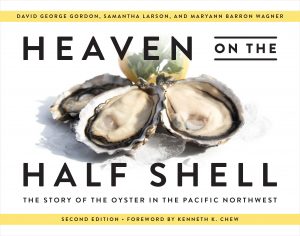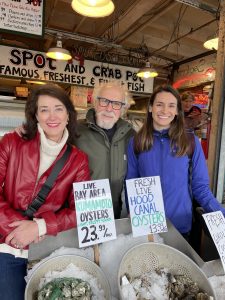The second edition of this classic text is now in bookstores
 Generations of oyster farmers have weathered many challenges to continue the harvest. Their stories are braided together with significant history that have defined the modern-day Pacific Northwest: the arrival of white settlers intent on capitalizing on the rich natural resources, World War II and its effects on Japanese Americans, the Fish Wars of the 1970s that led to the landmark court cases that affirmed rights held by treaty tribes in Washington.
Generations of oyster farmers have weathered many challenges to continue the harvest. Their stories are braided together with significant history that have defined the modern-day Pacific Northwest: the arrival of white settlers intent on capitalizing on the rich natural resources, World War II and its effects on Japanese Americans, the Fish Wars of the 1970s that led to the landmark court cases that affirmed rights held by treaty tribes in Washington.
The second edition of Heaven on the Half Shell, released by University of Washington Press in April 2023, offers a thoroughly researched and richly illustrated history of those significant events noted above and many more that tell the story of the Pacific Northwest’s beloved bivalve, the oyster. Starting with the earliest evidence of sea gardens and clam beds from 11,500 years ago, this book covers the history of oyster cultivation through contemporary aquaculture in coastal Washington, Oregon, British Columbia, northern California, and southeastern Alaska. The book was produced in partnership with Washington Sea Grant (WSG).
WSG and WestWinds Press published the first edition in 2001. “It all started when Bruce Brenner came to us with his father’s scrapbooks,” says co-author David George Gordon, who served as WSG science writer from 1998 to 2012. The scrapbooks contained newspaper clippings and other tidbits assembled during Earl R. Brenner’s 60-plus-year career as an oyster grower with the J.J. Brenner Oyster Company, which is the oldest continuously operating oyster enterprise on Puget Sound.
“As we studied the Brenner scrapbooks, we became painfully aware of how much of the oyster industry’s record of achievements had already been lost, largely due to neglect. Many of the industry’s most distinguished historians, the sons and daughters of the pioneering oyster farmers, had passed away in recent years,” Gordon says. Gordon and the other co-authors of the first edition — Nancy E. Blanton and Terry Y. Nosho — vowed to do everything in their power to record that history. And so, the first book was born.
Nearly 20 years later, Gordon realized how much the oyster industry had changed since the book’s first publication. Emerging issues, such as ocean acidification and heat waves, now threaten growers crops. At the same time, some of the hurdles faced by the previous generation had been overcome: for example, getting invasive spartina under control, and meeting the the rising demand for oysters on the half shell through the development of triploid oysters and growing techniques, such as flipped oysters.
Gordon partnered with Samantha Larson, the current WSG science writer, and MaryAnn Barron Wagner, assistant director of communications at WSG, to bring the book up to speed in a second edition. Crafting a new edition presented the opportunity to expand upon important history that wasn’t fully covered in the first book, and also allowed the authors to include more expertise, quotes, anecdotes, and photos of women and people of color throughout the text.

From left: MaryAnn Barron Wagner, David George Gordon and Samantha Larson.
“We greatly expanded and centralized our telling of Native American history,” says Larson. “We added context about the Chinook, Chehalis, Shoalwater Bay, and other Tribes and how those people relied on the fruits of Willapa Bay and Puget Sound since time immemorial.” The new edition also covers the landmark 1994 Rafeedi Decision, which affirmed the rights of treaty tribes in Washington to harvest shellfish from their usual and accustomed areas. The Rafeedi Decision subsequently led to settlements through which tribes bought and leased tidelands – and how that contributed to many tribes in the state owning and operating commercial shellfish farms today.
The second edition is about twice the length with double the number of photos from the first edition, and is chock-full of new “oysterabilia.” In addition, the authors worked with Pacific Northwest chefs and foodies to find interesting and delicious ways to prepare oysters.
“Overall, the book shares 22 recipes, embracing both traditional and contemporary ways of preparing oysters,” says Wagner. “The recipes include styles of cooking oysters that have gone out of fashion but still taste good and are worthy of remembering.” For example, the book includes a mid-century recipe for pan seared roasted oysters by Aunt Gert of Hoquiam, and an 1885 recipe for native Olympia oysters from the very first Northwest cookbook. Modern recipes include contributions from celebrity chefs such as Ethan Stowell and Renee Erickson as well as innovative contributions from tribal communities, shellfish growers and restauranteurs.
Heaven on the Half Shell tells a story of place, people, nature and food, and weaves them together to illustrate how those elements have changed and shaped the industry over time. If there is a theme of the book, it’s the adaptability and evolution of the people who farm, harvest, sell and eat a much beloved shellfish — with an emphasis on eat! After all, as the traditional Native American saying goes, when the tide is out, the table is set.
###
Washington Sea Grant, based at the University of Washington, helps people and marine life thrive through research, technical expertise and education supporting the responsible use and conservation of coastal ecosystems. The National Sea Grant College Program is part of the National Oceanic and Atmospheric Administration, U.S. Department of Commerce.
Join the conversation: @WASeaGrant and Facebook.com/WaSeaGrant.
APR
2023